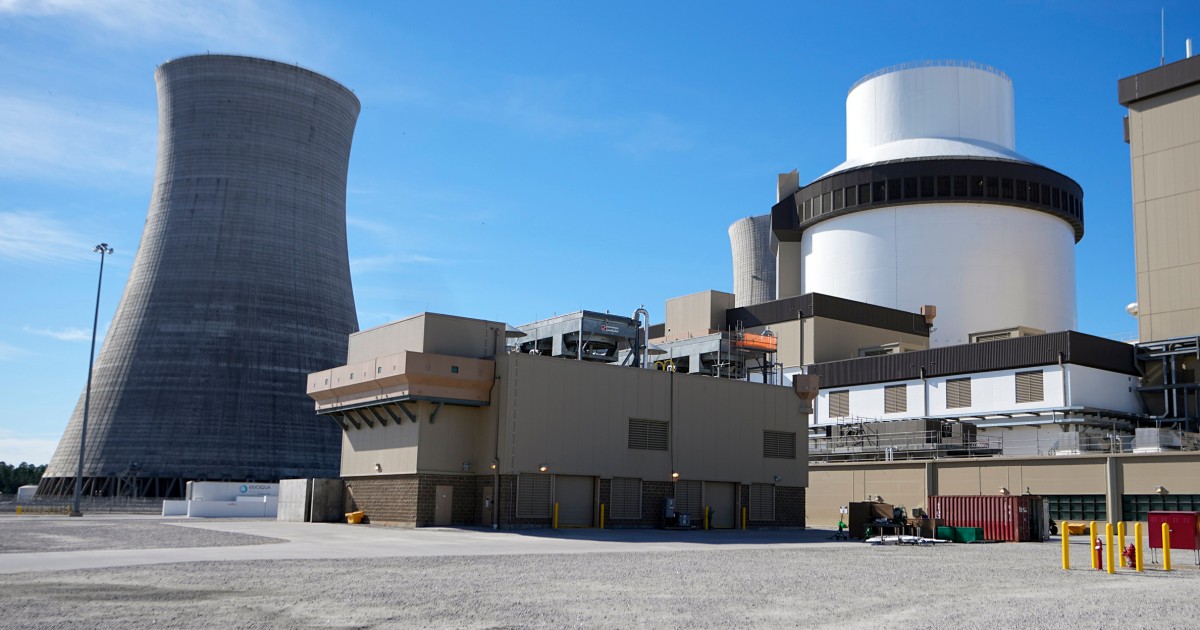First U.S. nuclear reactor built from scratch in decades enters commercial operation in Georgia::ATLANTA — A new reactor at a nuclear power plant in Georgia has entered commercial operation, becoming the first new American reactor built from scratch in decades.
I highly, highly recommend the Oliver Stone documentary Nuclear Now from earlier this year. Completely changed my perspective. I had no idea that the oil industry was behind so much of the fear mongering around nuclear.
14 years and 35 billion (combined with #4 which has not been finished) and didn’t generate a single kWh in anger until now. Put the same investment into renewables and it would generate similar or greater energy and would start doing so within a year.
The argument against nuclear now is not about safety. It is about money. Nuclear simply cannot compete without massive subsidies.
Good news. Anything but fossil fuels at this point.
The reduced operating emissions take 10+ years to outweigh the enormous construction emissions of nuclear. (Compared to gas.)
Fortunately the nuclear reactor can be operated for >50 years :)
Ooh a lot of people here seem very pro-nuclear-power. That’s cool!
Oh, neat. My state did something not completely stupid. I’ve got some reservations about nuke power as opposed to renewable, but this is definitely better than continuing fossil fuels.
Fission and fusion reactors are really more like in-between renewable and non-renewable. Sure, it relies on materials that are finite, but there is way, way more of that material available in comparison to how much we need.
Making this distinction is necessary to un-spook people who have gone along with the panic induced by bad media and lazy engineering of the past.
redacted
I’m spooked by the fact that you have no idea how the US enriches uranium, or the difference between a power pressurized water reactor and a fast “breeder” reactor (if you were thinking of plutonium) or a centrifuge.
The US enriches uranium using a gas-centrifuge. The US also no longer recycles spent nuclear fuel, but France does.
redacted
Nuclear is expensive and dangerous to life. It should be avoided going forward.
Statistics would disagree. It is very expensive though, so it should be one of many solutions.
In my opinion should be:
- Renewables
- Nuclear
- Storage
Storage could just be reusing batteries from old EVs to store energy. Already saw some cases of companies actually using the EV itself to store the energy produced from renewables (for some reason I can’t remember it was more profitable to use it like that).
The only issue I foresee with using regular batteries as grid wide storage is cost. Many renewable sources are inherently unstable in output, so one would have to plan for potentially multi day deficits in production.
At least in my country some alternative storage solutions are being planned. One company wants to use excess wind power to produce hydrogen. That hydrogen could then be used to offset potential production deficits.
Otherwise I very much agree with your list.
That seems to be a good idea. There are more efficient hydrogen production methods in the works as far as I know so it would help to have more innovation in that field, specially with the production and the storage. If we could find a lightweight solution to store hydrogen safely we could probably replace fossil fuels in planes.
My personal dream scenario is one, where renewables and nuclear become such cheap production methods, that electricity is cheap and abundant.
At that point one could just use that energy to synthesize fuel to avoid the hassle that is hydrogen storage.
We need to go carbon negative, not neutral. So, everywhere we can avoid dump CO2 into the atmosphere is good.
This being said, if we could do it from carbon captured CO2…
Currently, the owners are projected to pay $31 billion in capital and financing costs, Associated Press calculations show. Japan’s Toshiba Corp., which then owned Westinghouse, paid $3.7 billion to the Vogtle owners to walk away from a guarantee to build the reactors at a fixed price after overruns forced electric industry pioneer Westinghouse into bankruptcy in 2017. Add that to Vogtle’s price and the total nears $35 billion.
Does this seem strange to include the 3.7 billion in here? I guess when you’re used to costs meaning what it cost the purchaser of said product or service it seems weird. Like, if I was the group paying for this I might even think to reduce the reported cost by 3.7 billion.
That’s copied from the AP news article the post’s nbcnews article links to. Similar statement in the nbcnews one, but…they don’t let you highlight any text? Lame.
Yeah, for sure thats a cost savings if your contractor pays you back $3.7 billion to walk away. Thats almost 15% of the total cost for the project, which is:
$35B - $3.7B = $27.3B
Either the journalist can’t add and subtract, or they printed that intentionally to make it seem worse. As if a 100% cost escalation wasn’t bad enough, lol. Although that was probably inevitable due to inflation.
Here’s another interesting idea for nuclear: small modular plants.
SMRs are in my opinion the future. They’re a lot safer, can be deployed basically everywhere and are scalable. That technology should have a lot more investment going in.
Only if governments didn’t spent trillions trying to cure a flu, they’d have money to invest in these technologies.
Oh wow really? Hope it kicks off some good news for other plants in the future.
The good news - it’s online, generating clean power, and hopefully demonstrating the safety and benefits of modern nuclear plants.
The bad news - it’s $17B over budget (+120%) and 7 years behind schedule (+100%). Those kind of overages aren’t super promising for investors, but perhaps there are enough lessons learned on this one that will help the next one sail a little smoother.
Either way, good to see it can still be done in the US.
I wouldn’t call it “clean power”. We still don’t have a good solution for the nuclear waste.
Edit: Downvotes because I am not religiously defending a technology and pointing out that there are downsides (EVERYTHING HAS DOWNSIDES!). Too many people from reddit here already.
We do, Japan, France have been doing it for years. It’s forbidden in US due to the fear of the material being used to make nuclear bombs.
The plan, called Cigéo, would involve placing the waste 500 metres (1,640 ft) below ground in a clay formation in eastern France.
Construction is expected in 2027 if it gets approval. Among those opposed to it are residents of the nearby village of Bure and anti-nuclear campaigners.
Burrying waste is not exactly clean. Yes, they reduce the waste. But they are also hitting limits and have challenges in increasing capacities.
In spite of the war in Ukraine, which has made many in the West avoid doing business with Russia, EDF is expected to resume sending uranium to Russia this year as the only country able to process it. It declined to confirm to Reuters it would do so.
That is also not really cool. I also find it a bit shady that something is only doable in Russia. That sounds a bit like it’s only possible there, because they ignore safety rules any other country would have in place and we don’t care because “now it’s their problem”.
For what I’m been reading online, that would be a waste of perfectly functioning nuclear material: check Nuclear reprocessing.
It a material remains radioactive means it still has energy in it, so the goal should be using it to the maximum. SMRs for example, might use reprocessed nuclear material at their core.
Let it run 5 months and the money is back in.
Not really. All costs considered, nuclear is one of the most expensive energy sources.
Yes nuclear power plants are very expensive. But the energy density is phenomenal.
Energetic armortisation is far quicker on a nuclear plant than on solar panels.
And the argument of subsidies is usually a fake one, since governments also pour millions into renewable energies.
Broken down to lifetime cost to the cost of comparable technologies, nuclear is still on the same level as solar and wind.
Since I am from Germany, and German sources might not be ideal to share, let me explain it this way: People are not stupid. They will never choose the financially unwise option, if the other one would seriously be the better one.
People do often act stupid, but you are seeing it from what I consider to be an incomplete perspective. Nuclear could be financially unwise overall, but someone would still get a payday. That 17B over budget wasn’t burned and unmade, it went into the pockets of the people organizing and building the power plant.
All this to say, the huge majority of the people involved in making the power plant a reality weren’t motivated by the efficiency of the power production on a cost basis. Most of them were probably making more money while it was still being subsidized, planned, and built. And while I think subsidies are generally useful and good, they can be a vector of financial abuse when it comes to unprofitable industries.
Lastly “lifetime cost” is a bit of a useless metric when the majority of that lifetime comes too late. No point to a power source that will cleanly produce power after it has meaningfully contributed to pushing us over the edge and past the breaking point for a climate that can support agriculture as we know it. There isn’t enough time or margin for error in emissions left available to build all the nuclear plants needed to meet energy demands.
Can you find any recent analysis that supports your claim that nuclear costs are at the same level as solar?
The only one I’ve seen suggest this was from a nuclear industry lobby group, and it inflated the costs or solar by insane amounts.
In Australia this is a bit of a hot topic and all impartial estimates suggest that nuclear will not get close to renewables in any way, even taking into account storage and grid costs.
In the 10 years since this single reactor was built, one of our states has transitioned to almost 100% renewables. Wholesale costs have plummeted, but renewable projects are still profitable in the market. I was involved in a reactor project in a western nation some time ago (it’s still being completed unsurprisingly), and the lock-in wholesale price to support that project was simply extortionate. Solar generation prices are a whole magnitude smaller.
This is a German source that incorporates many studies and presents their results. Some agree with my statement, some with yours. But fact is, that the financial difference is very small.
Page 23 for example suggests my statement.
On page 32 you can see the development that suggests that you are right.
But considering the costs for the expansion of the energy grid, battery storage systems, and the rising production costs of everything, I believe Nuclear to be the cheaper option and the far more reliable one.
The nameplate cost of this plant is $32 per watt. Even at smaller scales, utility-scale solar plants are $1 per watt. Do you know how many grid storage batteries you could buy with the extra $31 per watt? (6 hour storage is around $2.50 per watt or $.40/Wh.) You could build a solar plant 4x the nameplate capacity of the nuke (in order to match the capacity factor), and add 24 hours of storage to make it fully dispatchable, and still have enough money left over to build 2 more of the same thing. This doesn’t even include the fact the nuclear has fuel costs, waste disposal, higher continued operational costs, and unaccounted publicly involuntarily subsidized disaster insurance.
Even at smaller scales, utility-scale solar plants are $1 per watt.
Solar is being built at 100% speed. We’re utilizing all the solar panel manufacturing capacity in the world building and deploying solar right now. There’s simply not enough rare earth metals to increase production more. Wind, Hydro, Nuclear and Geothermal are all needed of we want to replace coal and LNG power plants.
oyo
You can build entirely new solar supply chains from mining through manufacturing faster than a single new nuclear plant.
But solar panels take up a lot more space for the energy they give out than a nuclear plant iirc
i mean if you mix them all together and use land area for geothermal and solar or nuclear and solar you kinda fix the issue because solar’s issue is it takes up space but it can go in the same place as another thing like wind or nuclear or geothermal or hydro but it doesn’t work the other way too well, you can’t have wind efficiently at a nuclear place all the time, nor can you do geothermal at every nuclear plant or hydro
so tl;dr solar is useful for combined energy sources on already used land areas but otherwise its kinda dumb as a primary energy source so is wind on land for other reasons but if you combined wave or other hydro, wind, and solar all together it’d be great though idk how good that’d be for the ocean cuz you’re occluding sunlight
its a whole intricate balance tbh
Let’s play around with the thought of powering all of America with renewables. America’s coal, gas, petroleum and nuclear plants generate a combined baseload power of 405 GWavg, or “gigawatts average.” (Remember, a gigawatt is a thousand megawatts.) Let’s replace all of them with a 50 / 50 mix of onshore wind and CSP (solar), and since our energy needs are constantly growing, let’s round up the total to 500 GWs, which is likely what we’ll need by the time we finish. Some folks say that we should level off or reduce our consumption by conserving and using more efficient devices, which is true in principle. But in practice, human nature is such that whatever energy we save, we just gobble up with more gadgets. So we’d better figure on 500 GWs.
To generate this much energy with 1,000 of our 500 MW renewables farms, we’ll put 500 wind farms in the Midwest (and hope the wind patterns don’t change…) and we’ll put 500 CSP farms in the southwest deserts—all of it on free federal land and hooked into the grid. Aside from whatever branch transmission lines we’ll need (which will be chump change), here’s the lowdown:
Powering the U.S. with 500 wind and 500 CSP farms, at 500 MWavg apiece.
Steel ……………….. 503 Million tonnes (5.6 times annual U.S. production) Concrete ………….. 1.57 Billion t (3.2 times annual U.S. production) CO2 …………………. 3.3 Billion t (all U.S. passenger cars for 2.5 years) Land ………………… 91,000 km2 (302 km / side)35,135 sq. miles (169 mi / side)
(the size of Indiana)
60-year cost ……… $29.25 Trillion
That’s 29 times the 2014 discretionary federal budget.
If we can convince the wind lobby that they’re outclassed by CSP, we could do the entire project for a lot less, and put the whole enchilada in the desert:
Powering the U.S. with 1,000 CSP farms, producing 500 MWavg apiece.
Steel ………………. 787 Million t (1.6 times annual U.S. production) Concrete …………. 2.52 Billion t (5.14 times annual U.S. production) CO2 ………………… 3.02 Billion t (all U.S. passenger cars for 2.3 years) Land ……………….. 63,000 km2 (251 km / side)24,234 sq. miles (105.8 mi / side)
(the size of West Virginia)
60-year cost ……. $18.45 Trillion
#That’s to 18 times the 2014 federal budget.
Or, we could power the U.S. with 500 AP-1000 reactors.
Rated at 1,117 MWp, and with a reactor’s typical uptime of 90%, an AP-1000 will deliver 1,005 MWav. Five hundred APs will produce 502.5 GWav, replacing all existing U.S. electrical power plants, including our aging fleet of reactors.
The AP-1000 uses 5,800 tonnes of steel, 90,000 tonnes of concrete, with a combined carbon karma of 115,000 t of CO2 that can be paid down in less than 5 days. The entire plant requires 0.04km2, a patch of land just 200 meters on a side, next to an ample body of water for cooling. (Remember, it’s a Gen-3+ reactor. Most Gen-4 reactors won’t need external cooling.) Here’s the digits:
Steel ………. 2.9 Million t (0.5% of W & CSP / 0.36% of CSP) Concrete … 46.5 Million t (3.3% of W & CSP / 1.8% of CSP) CO2 ……….. 59.8 Million tonnes (2% of W & CSP / 1.5% of CSP) Land ………. 20.8 km2 (4.56 km / side) (0.028% W & CSP / 0.07% of CSP)1.95 sq. miles (1.39 miles / side)
(1.5 times the size of Central Park)
60-year cost ……… $2.94 Trillion
#That’s 2.9 times the 2014 federal budget.
Small Modular Reactors may cost a quarter or half again as much, but the buy-in is significantly less, the build-out is much faster (picture jetliners rolling off the assembly line), the resources and CO2 are just as minuscule, and they can be more widely distributed, ensuring the resiliency of the grid with multiple nodes.
And this is without even mentioning MSRs.
Was this project a complete shitshow of sheldon before seen-proportions?
Yes.
Does this mean that we should make the move towards powering the US from 100% renewables instead?
Well if you hate math and logic enough to even consider it, sure. Go ahead.
Uh.
The nuke plant is expensive. Renewables aren’t. And your argument ist essentially “but based on made up numbers that illustrate how inexpensive nuke plants could be, nuke plants could be much less expensive! Duh!”
Yeah, no. Build renewables.
I’m not quite why the argument is “nuclear or renewables.” It should be nuclear AND renewables.
Renewable energy generators have improved significantly in the last two decades. I’m sure they will continue to improve.
Nuclear power is a hell of a lot cleaner than coal. And it seems nuclear power plants have improved tremendously. We should use them.
It should be nuclear AND renewables.
It really shouldn’t be. Nuclear plants don’t emit co2, that’s right and that’s nice. However, they have so many disadvantages that I can’t wrap my head around how they could be considered a viable alternative to renewables.
- They are not economical. Full stop. Building and running them is expensive as fuck, like an order of magnitude over renewables.
- They’re risky. People usually argue that this point would be fearmongering, but there’s a simple solution for that: get insurance. That’s impossible though, no company wants to offer an insurance for nuke plants. Gee, I wonder why? This point adds to the economical issues - if the risk was properly calculated and the according price added to every watt, they would be even more expensive. The only solution here is to socialise the losses and risks - if one of them should ever blow up, society just has to eat it. There’s no other way to ruin these things.
- They need to be cooled. With the climate crisis just getting started, this is hard to calculate, but it’s already showing. France, with their 80-something percentage of nuclear power, has constant issues to power the country in summer when the rivers get too warm to efficiently cool the reactors. And god forbid one of those larger rivers ever running dry.
- The fuel is hard to get. Most countries need to import the fuel from countries you don’t want to depend on, like Russia. It’s also limited.
- It’s a very centralised solution. That means you’ll probably have to rely on corporate solutions, with community-run or private projects being essentially ruled out. That means, power will remain in corporate, for-profit hands. This is also the reason why I think a lot of astroturfing is taking place. Of all the carbon-neutral methods to generate electricity, this is the only one that is almost guaranteed to remain in the hands of the largest corporations. I also predict that any reactor that is at least said to be runnable by smaller communities won’t deliver on that promise for whatever reasons, probably safety and security.
- It’s not available. A new plant takes decades to build. Any of the new designs that are at least said to offer a solution to one or two of all those issues are not yet tested and will take even longer to be built in larger quantities. We need, however, to ramp up carbon neutral energy production now, not in ten years.
There’s my unpopular opinion.
This right here, we could more easily transition to nuclear from coal/oil while building up the infrastructure and scale needed for renewables. In time we can phase out nuclear but at least we could have a stop gap fix in the meantime.
Solar doesn’t perform at its nameplate capacity, so you have to overbuild the capacity by about 200% in order to achieve the same baseload as a constant output thermal plant.
And that doesn’t even touch on the fact that solar doesn’t work at night, and the capacity is much lower during the different seasons in Northern latitudes.
So you either build a shitton of batteries, provide backup power sources, or tell people not to use energy during the winter. According to Tesla, they sell their Megapack batteries for around $1/watt-hour of storage. Still, lets figure a 1 Ghwr battery for every 1 GW of installed capacity of solar. That should give the system a few hours of runtime after it gets dark.
So instead of your 500 GW solar capacity, we need 1,000 GW. And 1,000 Gwhr of batteries. $68.50 Trillion worth of solar + $1 Trillion for batteries.
However, I’m a little skeptical on your solar costs. Utility scale solar is typically cited as between $1-$2/watt installed. So for 1,000 GW that gives you $1 Trillion installed. Which is a lot of money, but less than Biden’s student load forgiveness plan.
I personally believe, after spending 3 years listening to the Energy Gang podcast, that decarbonizing the energy system is an ‘all-hands on deck’ emergency that will require every trick in the book to tackle. We will likely max out every type of cheap and readily financeable energy system on this road.
Ah, i remember studying the Westinghouse AP1000 reactor design when I was at Uni. It had just been approved, and numerous plants were expected, with the first expected to be online from around 2010.
It’s 2023, and this is the first one to go live in the US.












